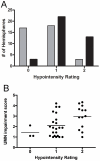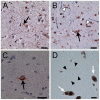Iron accumulation in deep cortical layers accounts for MRI signal abnormalities in ALS: correlating 7 tesla MRI and pathology
- PMID: 22529995
- PMCID: PMC3328441
- DOI: 10.1371/journal.pone.0035241
Iron accumulation in deep cortical layers accounts for MRI signal abnormalities in ALS: correlating 7 tesla MRI and pathology
Abstract
Amyotrophic lateral sclerosis (ALS) is a progressive neurodegenerative disorder characterized by cortical and spinal motor neuron dysfunction. Routine magnetic resonance imaging (MRI) studies have previously shown hypointense signal in the motor cortex on T(2)-weighted images in some ALS patients, however, the cause of this finding is unknown. To investigate the utility of this MR signal change as a marker of cortical motor neuron degeneration, signal abnormalities on 3T and 7T MR images of the brain were compared, and pathology was obtained in two ALS patients to determine the origin of the motor cortex hypointensity. Nineteen patients with clinically probable or definite ALS by El Escorial criteria and 19 healthy controls underwent 3T MRI. A 7T MRI scan was carried out on five ALS patients who had motor cortex hypointensity on the 3T FLAIR sequence and on three healthy controls. Postmortem 7T MRI of the brain was performed in one ALS patient and histological studies of the brains and spinal cords were obtained post-mortem in two patients. The motor cortex hypointensity on 3T FLAIR images was present in greater frequency in ALS patients. Increased hypointensity correlated with greater severity of upper motor neuron impairment. Analysis of 7T T(2)(*)-weighted gradient echo imaging localized the signal alteration to the deeper layers of the motor cortex in both ALS patients. Pathological studies showed increased iron accumulation in microglial cells in areas corresponding to the location of the signal changes on the 3T and 7T MRI of the motor cortex. These findings indicate that the motor cortex hypointensity on 3T MRI FLAIR images in ALS is due to increased iron accumulation by microglia.
Trial registration: ClinicalTrials.gov NCT00334516.
Conflict of interest statement
Figures







References
-
- Ince PG, Evans J, Knopp M, Forster G, Hamdalla HH, et al. Corticospinal tract degeneration in the progressive muscular atrophy variant of ALS. Neurology. 2003;60:1252–1258. - PubMed
-
- Ellis CM, Simmons A, Jones DK, Bland J, Dawson JM, et al. Diffusion tensor MRI assesses corticospinal tract damage in ALS. Neurology. 1999;53:1051–1058. - PubMed
-
- Mitsumoto H, Ulug AM, Pullman SL, Gooch CL, Chan S, et al. Quantitative objective markers for upper and lower motor neuron dysfunction in ALS. Neurology. 2007;68:1402–1410. - PubMed
-
- Hecht MJ, Fellner F, Fellner C, Hilz MJ, Neundorfer B, et al. Hyperintense and hypointense MRI signals of the precentral gyrus and corticospinal tract in ALS: a follow-up examination including FLAIR images. J Neurol Sci. 2002;199:59–65. - PubMed
Publication types
MeSH terms
Substances
Associated data
Grants and funding
LinkOut - more resources
Full Text Sources
Medical
Miscellaneous

